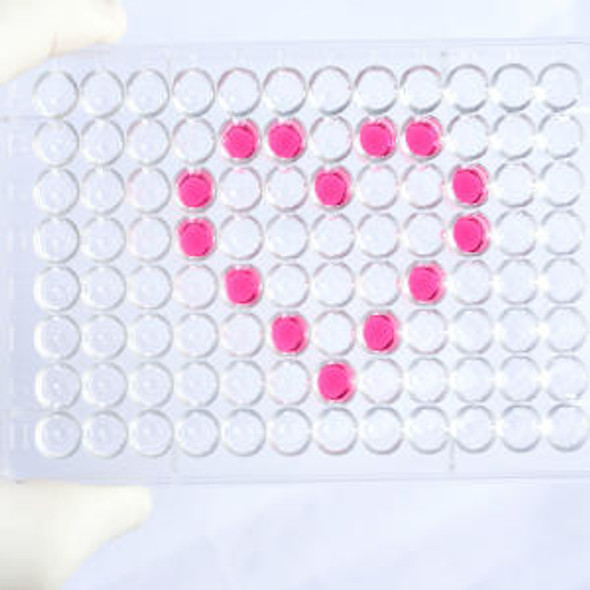Cell Biology Antibodies 15
Anti-TCF3 Antibody (CAB20013)
- SKU:
- CAB20013
- Product Type:
- Antibody
- Reactivity:
- Human
- Reactivity:
- Mouse
- Reactivity:
- Rat
- Host Species:
- Rabbit
- Isotype:
- IgG
- Research Area:
- Cell Biology
Description
| Antibody Name: | Anti-TCF3 Antibody |
| Antibody SKU: | CAB20013 |
| Antibody Size: | 20uL, 50uL, 100uL |
| Application: | WB |
| Reactivity: | Human, Mouse, Rat |
| Host Species: | Rabbit |
| Immunogen: | Recombinant protein of human TCF3 |
| Application: | WB |
| Recommended Dilution: | WB 1:500 - 1:2000 |
| Reactivity: | Human, Mouse, Rat |
| Positive Samples: | HeLa, HCT116, Jurkat |
| Immunogen: | Recombinant protein of human TCF3 |
| Purification Method: | Affinity purification |
| Storage Buffer: | Store at -20°C. Avoid freeze / thaw cycles. Buffer: PBS with 0.02% sodium azide, pH7.3. |
| Isotype: | IgG |
| Sequence: | Email for sequence |
| Gene ID: | 6929 |
| Uniprot: | P15923 |
| Cellular Location: | Nucleus |
| Calculated MW: | 67kDa/68kDa |
| Observed MW: | 70kDa |
| Synonyms: | TCF3, AGM8, E2A, E47, ITF1, TCF-3, VDIR, bHLHb21 |
| Background: | This gene encodes a member of the E protein (class I) family of helix-loop-helix transcription factors. E proteins activate transcription by binding to regulatory E-box sequences on target genes as heterodimers or homodimers, and are inhibited by heterodimerization with inhibitor of DNA-binding (class IV) helix-loop-helix proteins. E proteins play a critical role in lymphopoiesis, and the encoded protein is required for B and T lymphocyte development. Deletion of this gene or diminished activity of the encoded protein may play a role in lymphoid malignancies. This gene is also involved in several chromosomal translocations that are associated with lymphoid malignancies including pre-B-cell acute lymphoblastic leukemia (t(1;19), with PBX1), childhood leukemia (t(19;19), with TFPT) and acute leukemia (t(12;19), with ZNF384). Alternatively spliced transcript variants encoding multiple isoforms have been observed for this gene, and a pseudogene of this gene is located on the short arm of chromosome 9. |
| UniProt Protein Function: | E2A: a transcription factor that plays major roles in determining tissue-specific cell fate during embryogenesis, like muscle or early B-cell differentiation. Heterodimers between E2A and tissue-specific basic helix-loop-helix (bHLH) Dimers bind DNA on E-box motifs: 5'- CANNTG-3'. Binds to the kappa-E2 site in the kappa immunoglobulin gene enhancer. Deletions in E2A have been observed in a subset of pre-B-cell acute lymphoblastic leukemia (B-ALL) cases. Two alternatively spliced human isoforms have been described. |
| UniProt Protein Details: | Protein type:Transcription factor; DNA-binding; Oncoprotein Chromosomal Location of Human Ortholog: 19p13.3 Cellular Component: cytoplasm; nuclear chromatin; nucleoplasm; nucleus; transcription factor complex Molecular Function:bHLH transcription factor binding; DNA binding; mitogen-activated protein kinase kinase kinase binding; protein binding; protein heterodimerization activity; protein homodimerization activity; transcription coactivator activity; transcription factor activity; transcription factor binding Biological Process: immunoglobulin V(D)J recombination; negative regulation of transcription from RNA polymerase II promoter; positive regulation of muscle cell differentiation; positive regulation of neuron differentiation; positive regulation of transcription factor activity; positive regulation of transcription from RNA polymerase II promoter; positive regulation of transcription, DNA-dependent; transcription, DNA-dependent |
| NCBI Summary: | This gene encodes a member of the E protein (class I) family of helix-loop-helix transcription factors. E proteins activate transcription by binding to regulatory E-box sequences on target genes as heterodimers or homodimers, and are inhibited by heterodimerization with inhibitor of DNA-binding (class IV) helix-loop-helix proteins. E proteins play a critical role in lymphopoiesis, and the encoded protein is required for B and T lymphocyte development. Deletion of this gene or diminished activity of the encoded protein may play a role in lymphoid malignancies. This gene is also involved in several chromosomal translocations that are associated with lymphoid malignancies including pre-B-cell acute lymphoblastic leukemia (t(1;19), with PBX1), childhood leukemia (t(19;19), with TFPT) and acute leukemia (t(12;19), with ZNF384). Alternatively spliced transcript variants encoding multiple isoforms have been observed for this gene, and a pseudogene of this gene is located on the short arm of chromosome 9. [provided by RefSeq, Sep 2011] |
| UniProt Code: | P15923 |
| NCBI GenInfo Identifier: | 135655 |
| NCBI Gene ID: | 6929 |
| NCBI Accession: | P15923.1 |
| UniProt Secondary Accession: | P15923,P15883, Q14208, Q14635, Q14636, Q2TB39, Q2TB40 Q9UPI9, |
| UniProt Related Accession: | P15923 |
| Molecular Weight: | 68,510 Da |
| NCBI Full Name: | Transcription factor E2-alpha |
| NCBI Synonym Full Names: | transcription factor 3 |
| NCBI Official Symbol: | TCF3 |
| NCBI Official Synonym Symbols: | E2A; E47; AGM8; ITF1; VDIR; TCF-3; bHLHb21 |
| NCBI Protein Information: | transcription factor E2-alpha |
| UniProt Protein Name: | Transcription factor E2-alpha |
| UniProt Synonym Protein Names: | Class B basic helix-loop-helix protein 21; bHLHb21; Immunoglobulin enhancer-binding factor E12/E47; Immunoglobulin transcription factor 1; Kappa-E2-binding factor; Transcription factor 3; TCF-3; Transcription factor ITF-1 |
| Protein Family: | TCF3 fusion partner |
| UniProt Gene Name: | TCF3 |
| UniProt Entry Name: | TFE2_HUMAN |







